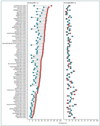Childhood dual burden of under- and overnutrition in low- and middle-income countries: a critical review
- PMID: 25076771
- PMCID: PMC4313560
- DOI: 10.1177/156482651403500210
Childhood dual burden of under- and overnutrition in low- and middle-income countries: a critical review
Abstract
Background: In low- and middle-income countries, the distribution of childhood nutritional diseases is shifting from a predominance of undernutrition to a dual burden of under- and overnutrition. This novel and complex problem challenges governments and health organizations to tackle opposite ends of the malnutrition spectrum. The dual burden may manifest within a community, household, or individual, but these different levels have not been addressed collectively.
Objective: To critically review literature on the prevalence, trends, and predictors of the dual burden, with a focus on children from birth to 18 years of age.
Methods: We reviewed literature since January 1, 1990, published in English, using the PubMed search terms nutrition transition, double burden, dual burden, nutrition status, obesity, overweight, underweight, stunting, body composition, and micronutrient deficiencies. The findings were classified and described according to dual burden level (community, household, or individual).
Results: Global trends indicate decreases in diseases of undernutrition, while overnutrition is increasing. On the community level, economic status may influence the extent of the dual burden, with obesity increasingly affecting the already undernourished poor. In a household, shared determinants of poor nutritional status among members can result in disparate nutritional status across generations. Within an individual, obesity may co-occur with stunting or anemia due to shared underlying determinants or physiologic links.
Conclusions: The dual burden of malnutrition poses a threat to children's health in low- and middle-income countries. We must remain committed to reducing undernutrition while simultaneously preventing over-nutrition through integrated child health programs that incorporate prevention of infection, diet quality, and physical activity.
Conflict of interest statement
None of the authors have conflicts of interest to declare.
Figures


References
-
- Popkin BM. The nutrition transition in low-income countries: an emerging crisis. Nutr. Rev. 1994 Sep;52:285–298. - PubMed
-
- Gillespie SR, Haddad LJ. The Double Burden Of Malnutrition In Asia : Causes, Consequences, And Solutions. Sage Publications India Pvt Limited; 2003.
-
- Popkin BM, Richards MK, Montiero CA. Stunting is Associated with Overweight in Children of Four Nations That Are Undergoing the Nutrition Transition. J. Nutr. 1996 Dec;126:3009–3016. - PubMed
-
- Doak CM, Adair LS, Bentley M, Monteiro C, Popkin BM. The dual burden household and the nutrition transition paradox. Int J Obes (Lond) 2005 Jan;29:129–136. - PubMed
-
- Doak CM, Adair LS, Monteiro C, Popkin BM. Overweight and underweight coexist within households in Brazil, China and Russia. J. Nutr. 2000 Dec;130:2965–2971. - PubMed
Publication types
MeSH terms
Substances
Grants and funding
LinkOut - more resources
Full Text Sources
Other Literature Sources
Medical

